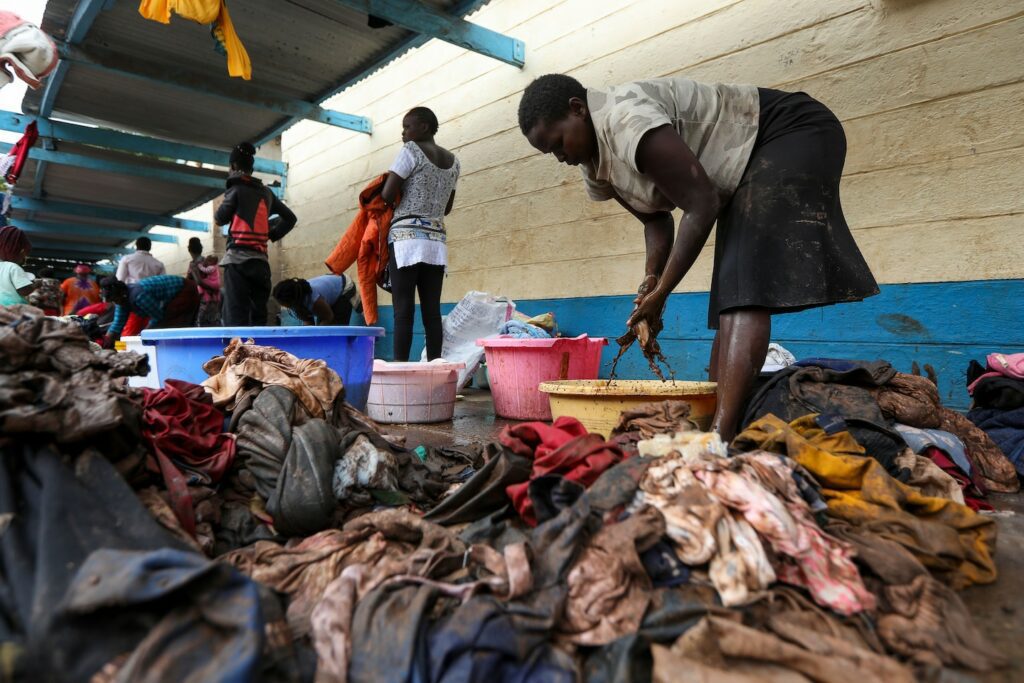Kenya Wiley is a policy counsel and fashion law professor at Georgetown University. She previously served as counsel and senior policy adviser for the Senate Homeland Security and Governmental Affairs Committee.
If you’ve donated clothing to a local charity or tossed your stained shirts in a drop-off bin, chances are your discarded items will be dumped in Africa, winding up in landfills, water and eventually breaking down into microplastics. Your castoff T-shirt will be among millions of items harming human health, marine life and local economies. In 2021, the United States was the leading exporter of secondhand clothing, according to United Nations data, and Africa was one of the main destinations for these goods. The intention is for vendors to sell at African markets, but the quality of the used clothing — referred to as mitumba — is often so poor and soiled that the items are dumped or burned as fuel.
This week, Kenyan President William Samoei Ruto is making an official state visit to the United States, marking the first time in nearly 16 years for an African leader to do so. President Biden and Ruto are discussing trade and investment between the two countries, but there’s one part of trade policy that must not be overlooked: the billion dollars of used clothing we ship every year that ends up as textile waste in Kenya, Ghana, Tanzania and other countries in sub-Saharan Africa.
Transforming a decades-old trade law can address the mitumba problem. The African Growth and Opportunity Act (AGOA) — a trade preference program between the United States and certain African countries — was first signed into law in 2000 and is set to expire in 2025. It provides duty-free treatment to encourage trade and investment in apparel and other products, but it does not go far enough. The initiative should expand its focus beyond apparel manufacturing, as AGOA-eligible countries have done for years, but also encourage investments in recycling infrastructure to tackle the escalating textile waste problem.
This revision would help spur private investments for start-ups to scale recycling innovation in Africa — for both low-quality secondhand clothing and fabric scraps from factories in countries where apparel manufacturing is on the rise. Fabric recycling is a multifaceted process, requiring advanced chemistry for cleaning, funding for technology developments in artificial intelligence to identify and sort fiber blends, and mechanical engineering to transform old tees into new materials. Establishing robust recycling infrastructure in Africa will demand support from both the public and private sectors.
For a bipartisan precedent that can guide the needed revisions, look no further than the Save Our Seas 2.0 Act, the 2020 law Congress passed to combat ocean plastic pollution worldwide. That was followed by USAID’s launch of the Save Our Seas Initiative, with support from U.S. and international businesses. Such a blueprint can be used in the reauthorization of AGOA to tackle textile waste in Africa, foster innovation and empower entrepreneurs.
Yet cleaning up Africa’s existing textile waste will address only part of the problem. Investing in talent across the continent is crucial to prevent future pollution. African entrepreneurs have age-old answers to environmental sustainability that must not be overlooked — particularly by brands striving for circular solutions so that items stay in use for longer periods.
Designing with durability has been a part of African cultures for centuries, using weaving techniques and high-quality fabrics passed from generation to generation. Young entrepreneurs are also leading the way in developing innovative products and materials across the continent — turning farm waste into biodegradable fabrics and fusing art and commerce to redesign secondhand items. In 2023, entrepreneurs in Kenya alone secured more than $600 million in start-up capital across green energy, agri-tech and logistics — sectors that will be pivotal in addressing Africa’s waste problem.
If used clothing is the problem, why not prohibit it altogether? The answer is that countries tried. In 2016, a group of East African countries joined forces to ban imports of secondhand clothing. In retaliation, the Trump administration threatened to remove the countries from the program that is at the core of U.S.-Africa trade policy if they followed through. No surprise that a lobby group representing used clothing sorters backed the move. The only country that stood firm was Rwanda and, to this day, its duty-free apparel benefits under AGOA remain suspended.
As the African Growth and Opportunity Act approaches its 25th anniversary, now is the time to ensure that its reauthorization upholds its original intent: Reduce trade barriers and foster economic development in sub-Saharan Africa, not stifle it. That starts with addressing textile waste.
Source link : https://www.washingtonpost.com/opinions/2024/05/22/clothes-donations-africa-kenya-waste/
Author :
Publish date : 2024-05-22 07:00:00
Copyright for syndicated content belongs to the linked Source.
